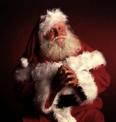The History of Santa Clause/St. Nick

This is a portraiture of the real St. Nicholas (Santa Claus)
A long time ago, a bishop named Nicholas lived in what is now the country of Turkey. Not a lot is known about him, but there are stories that he often helped children who were in need.
Many years later, Nicholas was made a saint and he became the patron saint of children. Today, December 6 (d.o.d.), is an important holiday in some countries in Europe as well as some states in America. This day is called St. Nicks day (and in some places in the United States, it's called stocking day.) On the night before St. Nick's day, children put out their shoes or hang up stockings. Early next morning, they rush to see what gifts St. Nick gave them.

In cities throughout the world, St. Nick visits towns and cities, leads parades, talks to children, and often hands out small gifts and candy canes, wearing a red and white robe and a hat.
St. Nick has many helpers. In many countries where English is the main language, these helpers are called Santa's Elves.

In the Netherlands, this helper is called Black Peter.
In Germany, they are Knecht Ruprecht.
In many parts of France, the helpers are called, Père Fouettard.
In Luxembourg, they are known as Hoesecker.
In days gone by, children loved St. Nick, but were afraid of his helpers. For it was told that is was the helpers who kept track of who had been naughty and who had been nice. Naughty children would get coal in their stockings and may even be carried away in the helper's bags until they learned to be good.
Currently, in America, if a child is naughty during the year, Santa may leave coal or a substance known as "snowman poop."
The poem that Santa includes with the snowman poop is: "You've been awfully bad, so here's the scoop. All you get in your stocking is snowman poop."
If a child gets coal or snowman poop in his stocking on St. Nick's day, they do have one more chance to behave. They must behave until Christmas Eve when if they have been good, Santa may return their real stocking with goodies inside.
St. Nick in other countries:
Author of the following section is unknown - Jaci Rae has modified and added to some of the information below to make it more complete.
The legend of Santa Claus can be traced back hundreds of years to a monk named St. Nicholas. It is believed that Nicholas was born sometime around 280 A.D. in Patara, near Myra in modern-day Turkey.
Much admired for his piety and kindness, St. Nicholas became the subject of many legends. It is said that he gave away all of his inherited wealth and traveled the countryside helping the poor and sick.
One of the best known of the St. Nicholas stories is that he saved three poor sisters from being sold into slavery or prostitution by their father by providing them with a dowry so that they could be married. Over the course of many years, Nicholas's popularity spread and he became known as the protector of children and sailors.
His feast day is celebrated on the anniversary of when he departed, December 6. This was traditionally considered a lucky day to make large purchases or to get married. By the Renaissance, St. Nicholas was the most popular saint in Europe. Even after the Protestant Reformation, when the veneration of saints began to be discouraged, St. Nicholas maintained a positive reputation, especially in Holland.
"United States and Canada ~ Presents are brought by Santa Claus. He drives through the sky in a sleigh drawn by eight reindeer, the reindeer of course are lead by Rudolph. He slips down the chimney, leaves gifts and is on his way again. Santa Claus wears red clothes trimmed with white fur, and has a snow-white beard and mustache.
England ~ The gift bringer is called Father Christmas. He looks much like Santa Claus, but has a longer coat and a longer beard.
France ~ Santa is known as Père Noël.
Brazil ~ Santa Claus is called Papa Noël.
Germany ~ Children get presents from Christkindl, the Christ child.
Costa Rica, Colombia, and parts of Mexico, ~ the gift bringer is el Niño Jesus, "the Infant Jesus."
Japan ~ Santa Kurohsu
Sweden ~ Gifts and goodies are brought by an elf called tomte. He's a Christmas gnome who has a sleigh that is pulled by goats.
Holland ~ Sinterklaas is what the Dutch call Saint Nicholas. He arrives in the city of Amsterdam by boat."
Christmas With Love Hosted and Written by (unless otherwise specified) Jaci Rae.
Copyright, Jaci Rae and North Shore Records, Inc.


